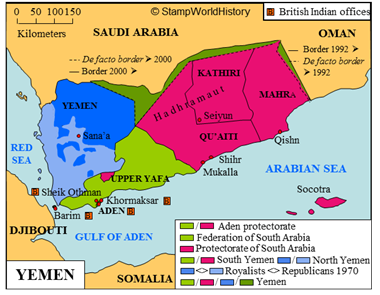اليَمَن

Yemen
Kingdom

Yemen
Arab republic

Yemen
Peoples republic

Yemen
Republic
Quick reference
General issues: Kingdom of Yemen 1918-1962, Kingdom of Yemen 1962-1970, Arab Republic of Yemen 1962-1990, Peoples Republic of Yemen 1967-1970, Democratic Peoples Republic of Yemen 1970-1990, Republic of Yemen 1990-Present
Country name on general issues:
- Kingdom of Yemen: Yemen, Royaume (al-Moutawakkiliyyah) du Yemen, (Moutawakelite) Kingdom of Yemen
- Arab Republic: Yemen Arab Republic, Y.A.R.
- (Democratic) Peoples Republic: People’s Republic of Southern Yemen, People’s Democratic Republic of Yemen, P.D.R.
- Republic of Yemen: Yemen Arab Republic, People’s Democratic Republic of Yemen, Republic of Yemen
Currency:
- North Yemen: 1 Imadi = 40 Bogash 1918-1962, 1 Rial = 40 Bogash 1962-1975, 1 Rial = 100 Fils 1975-1990
- South Yemen: 1 Dinar = 100 Fils 1967-1990
- Yemen: 1 Rial = 100 Fils 1990-Present
Population: 11 612 000 in 1990
Political history Yemen
Yemen is a country in western Asia on the Arabian peninsula. The northern part is, in the 19th century, part of the Ottoman Empire. As, after WWI, the Ottoman Empire dissolves, North Yemen gains independence as the kingdom of Yemen.[1]The terms North and South Yemen were introduced in the 1960’s to distinguish the then Arab republic of Yemen from the Peoples republic of Yemen. The terms have since been, retrospectively, used also for the period before the 1960’s. Although the terms are widely used, they have no official status. In 1962, a coup d’etat leads to the establishment of the Arab republic of Yemen. From 1962, republicans and royalists fight a civil war with the royalists gradually losing ground. The civil war ends in 1970 with a republican victory.
In South Yemen the British have, in 1839, captured Aden, and in 1886 formed the protectorate of Aden through a series of treaties with the emirates in the region. Aden is long governed from British India, in 1937 the city of Aden has become a British colony in its own right. In 1962, most of the western part of the protectorate of Aden, together with the colony of Aden, joins to form the Federation of South Arabia, still a British protectorate. In 1963, South Yemen starts a military struggle for independence. Independence is gained in 1967. The Federation and the protectorate of South Arabia subsequently join to form the peoples republic of Yemen. In 1970, South Yemen becomes a democratic peoples republic with a communist style single party system.
As of 1972, North and South Yemen negotiate unification, which is effected when the republic of Yemen is established in 1990. Yemen is a low income country that, although it is trying to diversify its economy, is still very much dependent on oil production. Politically, it has been less stable, thus being a place of refuge for international terrorist organizations such as al-Qaeda. The borders of Yemen with Saudi Arabia and Oman have long been provisional. The borders with Oman are formalized in 1992 and those with Saudi Arabia in 2000.
Postal history Yemen
North Yemen
In North Yemen, Turkish stamps are used until 1918. The kingdom of Yemen issues its first stamps in 1926 for domestic use. International mail is processed through Aden until Yemen joins the U.P.U. in 1930. During the civil war in North Yemen between 1962 and 1970, both the kingdom of Yemen and the Arab republic of Yemen issue stamps. The issues of the kingdom of Yemen from this period are disputed. Scott does not list these issues.
South Yemen
In South Yemen, postal services are established in the 19th century as part of the postal services of British India. As of 1937, Aden issues its own stamps for use both in the colony and the protectorate of Aden. Two emirates in the protectorate of Aden also acquire the right to issue stamps as they object to the portrait of the sovereign of Great Britain on the stamps of Aden. Kathiri State and Qu’aiti State thus issue stamps from 1942 on. The stamps of Aden are succeeded by the issues of the Federation of South Arabia. The emirates in the protectorate of South Arabia – Kathiri State and Qu’aiti State – continue to issue their own stamps. In 1967, Mahra State and the State of Upper Yafa – both also part of the protectorate of South Arabia – also issue stamps.[2]The stamps issued by these emirates after 1963 are disputed, Scott does not list them. The stamps of the Federation of South Arabian and the emirates are, in 1967, superseded by the issues of the peoples republic of – Southern – Yemen.
Yemen
When, in 1990, the republic of Yemen is formed, a two year transition period allows for the continued use of issues from the Arab and the peoples republics of Yemen concurrent with stamps issued by the republic of Yemen.
For an overview of the political and postal developments in the form of a diagram, please refer to the country diagram of Yemen.
Album pages
← Previous page: VietnamNext page: Abu Dhabi →





